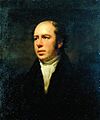John Thomson of Duddingston facts for kids
Rev John Thomson (born September 1, 1778 – died October 28, 1840) was a Scottish minister. He was also a very talented landscape painter. He served as the minister of Duddingston Kirk from 1805 until his death in 1840.
Contents
Life of John Thomson
John Thomson was the youngest of eight children. He was born in the manse (the minister's house) in Dailly, Ayrshire. His father, Rev Thomas Thomson, was also a local minister.
From a young age, John showed a great talent for drawing and painting. He loved the Ayrshire countryside, which inspired his landscape art.
In 1791, he started studying law and theology at the University of Glasgow. In 1793, he moved to the University of Edinburgh to study to become a minister. While in Edinburgh, he met many important people in the art world. These included the famous writer Walter Scott and artist Alexander Nasmyth. Nasmyth even gave John Thomson art lessons.
After finishing his studies, Thomson returned to Ayrshire. He became a minister in the Church of Scotland. In 1800, he took over from his father as the minister of Dailly. In 1805, he moved to Duddingston, a village near Edinburgh. He became the most famous minister of the local church, Duddingston Kirk. He stayed there until he passed away in 1840.
In 1814, he was chosen to be a Fellow of the Royal Society of Edinburgh. This is a special group for important thinkers and scientists.
A wonderful painting of him was made by Robert Scott Lauder. Robert later married Thomson's daughter, Isabella, in 1833.
John Thomson passed away in 1840 at the Duddingston manse. He had been a minister for 41 years. His grave in Duddingston churchyard has a unique stone tomb.
Thomson's Art and Style
John Thomson had a special art studio. It was at the bottom of the manse garden, right by Duddingston Loch. Later, a building called Duddingston Tower was built there. This tower was designed in 1825 by William Henry Playfair. The Duddingston Curling Society used the ground floor as their clubhouse. Thomson used the top floor of the tower as his studio. Today, this part is known as "Thomson's Tower."
Moving to Duddingston helped him connect with other important artists. It also helped him develop his painting skills. Like his first teacher, Alexander Nasmyth, Thomson believed in painting outdoors. He liked to observe nature directly.
He was influenced by famous artists like Salvator Rosa, Claude Lorrain, Nicolas Poussin, Henry Raeburn, and J. M. W. Turner. He developed a broad, Romantic style of landscape painting. He became a well-known landscape artist. Selling his paintings helped him earn more money and become quite wealthy.
Besides Walter Scott and Henry Raeburn, Thomson was also friends with writer and artist Thomas Dick Lauder. Thomson's reputation was so good that in 1818, he hosted J.M.W. Turner in his studio. Turner is said to have looked out over the loch and remarked, "By God sir, I envy you that piece of water." Thomson later worked with Turner. They created engravings for Walter Scott's book, Provincial Antiquities and Picturesque Scenery of Scotland, published in 1826.
His church members recognized his talent. They suggested he become a member of the Association of Artists in Edinburgh. He also received honorary memberships from other important art groups. These included the Royal Institution for the Encouragement of the Fine Arts in Scotland and the Royal Scottish Academy.
Thomson's Family
In 1801, John Thomson married Isabella Ramsay (1782-1809). She was the daughter of Rev John Ramsay. They had a daughter named Margaret (1806-1827). Their son, Thomas Thomson (1802-1873), later became the mayor of Stratford-upon-Avon. Another son, John Thomson (1803-1870), became a Captain. Their daughter Isabella Thomson (1809-1869) married the artist Robert Scott Lauder.
After Isabella passed away, John married Frances Ingram Spence (1779-1845) in 1813. She was a widow. They had more children: Francis Thomson (1814-1858), Henry Francis (born 1819), Edward (born 1821), Emily (born 1816), and Mary Helen (born 1817).
His older brother was Thomas Thomson, who was an expert in old things.
Memorials to John Thomson
John Thomson's nephew, Lochhart Thomson, put a special stained glass window in Duddingston Kirk in 1903. It is located near the pulpit.
Interesting Stories about Thomson
- John Thomson is often linked to a famous Scottish saying: "We're a' Jock Tamson's bairns". This means "We are all John Thomson's children" and is about everyone being equal and friendly. While it was used to describe him, the saying might have been around even before his time.
- One story says the saying came from his family life. His first wife died, leaving him with five children. He then married a widow who already had five children. Together, they had four more children. When visitors came, his wife would try to explain which children belonged to whom. Thomson would interrupt her, saying, "They're a' Jock Thomson's bairns!" This showed his belief that everyone was part of one big family. He was known for being forgiving and welcoming to everyone.
- To get privacy for painting in his studio, Thomson called his tower "Edinburgh." This way, if visitors came to the manse, his staff could say he was unavailable because he had "gone to Edinburgh."
- Duddingston Loch is famous for curling and skating. It is the setting for the well-known painting, The Skating Minister, by Thomson's friend, Henry Raeburn. However, the person in the painting is not John Thomson. It is actually Robert Walker, a minister from another church.
Images for kids
-
John Thomson
by Henry Raeburn -
Loch-an-Eilean, Rothiemurchus, Inverness-shire, 1835, Tate Gallery
-
Thomson sketched whilst working outdoors by his friend, Thomas Dick Lauder, 1831, National Gallery of Scotland





